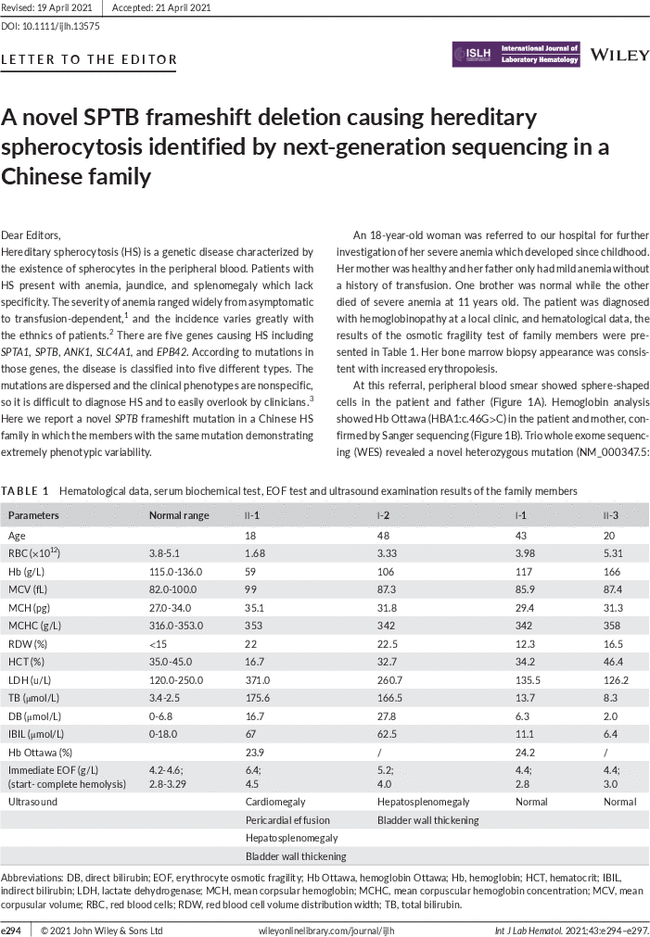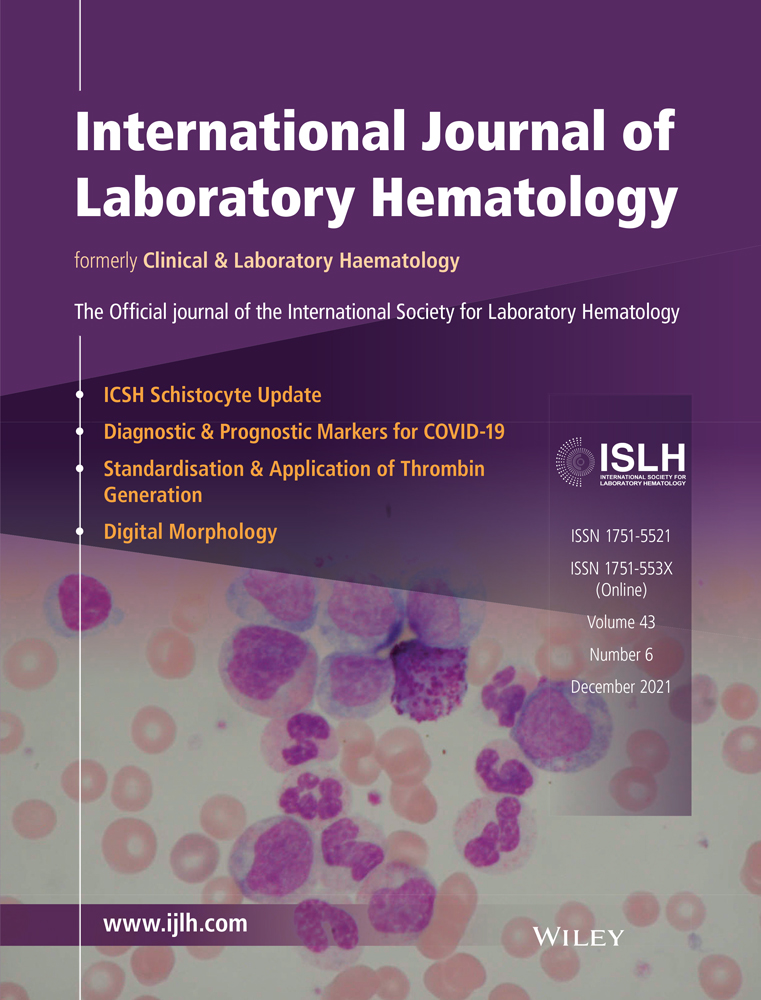A novel SPTB frameshift deletion causing hereditary spherocytosis identified by next-generation sequencing in a Chinese family
Ru-Qing Zhao
Panyu Maternal and Children Healthcare Hospital, Hexian Memorial Medical Hospital of Panyu District, Guangzhou, China
Search for more papers by this authorFan Jiang
Prenatal Diagnostic Center, Guangzhou Women and Children Medical Center, Guangzhou, China
Search for more papers by this authorJian Li
Prenatal Diagnostic Center, Guangzhou Women and Children Medical Center, Guangzhou, China
Search for more papers by this authorJian-Ying Zhou
Prenatal Diagnostic Center, Guangzhou Women and Children Medical Center, Guangzhou, China
Search for more papers by this authorXue-Wei Tang
Prenatal Diagnostic Center, Guangzhou Women and Children Medical Center, Guangzhou, China
Search for more papers by this authorFa-Tao Li
Prenatal Diagnostic Center, Guangzhou Women and Children Medical Center, Guangzhou, China
Search for more papers by this authorLi-Qiong Chen
Panyu Maternal and Children Healthcare Hospital, Hexian Memorial Medical Hospital of Panyu District, Guangzhou, China
Search for more papers by this authorCorresponding Author
Dong-Zhi Li
Prenatal Diagnostic Center, Guangzhou Women and Children Medical Center, Guangzhou, China
Correspondence
Dong-Zhi Li, Guangzhou Women and Children Medical Center, Guangzhou, Guangdong, China.
Email: [email protected]
Search for more papers by this authorRu-Qing Zhao
Panyu Maternal and Children Healthcare Hospital, Hexian Memorial Medical Hospital of Panyu District, Guangzhou, China
Search for more papers by this authorFan Jiang
Prenatal Diagnostic Center, Guangzhou Women and Children Medical Center, Guangzhou, China
Search for more papers by this authorJian Li
Prenatal Diagnostic Center, Guangzhou Women and Children Medical Center, Guangzhou, China
Search for more papers by this authorJian-Ying Zhou
Prenatal Diagnostic Center, Guangzhou Women and Children Medical Center, Guangzhou, China
Search for more papers by this authorXue-Wei Tang
Prenatal Diagnostic Center, Guangzhou Women and Children Medical Center, Guangzhou, China
Search for more papers by this authorFa-Tao Li
Prenatal Diagnostic Center, Guangzhou Women and Children Medical Center, Guangzhou, China
Search for more papers by this authorLi-Qiong Chen
Panyu Maternal and Children Healthcare Hospital, Hexian Memorial Medical Hospital of Panyu District, Guangzhou, China
Search for more papers by this authorCorresponding Author
Dong-Zhi Li
Prenatal Diagnostic Center, Guangzhou Women and Children Medical Center, Guangzhou, China
Correspondence
Dong-Zhi Li, Guangzhou Women and Children Medical Center, Guangzhou, Guangdong, China.
Email: [email protected]
Search for more papers by this author
CONFLICT OF INTEREST
The authors declare that they have no conflicts of interest.
REFERENCES
- 1King MJ, Garçon L, Hoyer JD, et al. ICSH guidelines for the laboratory diagnosis of nonimmune hereditary red cell membrane disorders. Int J Lab Hematol. 2015; 37(3): 304-325.
- 2Wang C, Cui Y, Li Y, Liu X, Han J. A systematic review of hereditary spherocytosis reported in Chinese biomedical journals from 1978 to 2013 and estimation of the prevalence of the disease using a disease model. Intractable Rare Dis Res. 2015; 4(2): 76-81.
- 3He BJ, Liao L, Deng ZF, et al. Molecular genetic mechanisms of hereditary spherocytosis: current perspectives. Acta Haematol. 2018; 139(1): 60-66.
- 4Hassoun H, Vassiliadis JN, Murray J, et al. Characterization of the underlying molecular defect in hereditary spherocytosis associated with spectrin deficiency. Blood. 1997; 90(1): 398-406.
- 5Meng LL, Yuan SM, Tu CF, et al. Next-generation sequencing identified a novel SPTB frameshift insertion causing hereditary spherocytosis in China. Ann Hematol. 2019; 98(1): 223-226.
- 6Liu Y, Zheng J, Song L, et al. A novel SPTB gene mutation in neonatal hereditary spherocytosis: a case report. Exp Ther Med. 2020; 20(4): 3253-3259.
- 7Gallagher PG, Weed SA, Tse WT, et al. Recurrent fatal hydrops fetalis associated with a nucleotide substitution in the erythrocyte beta-spectrin gene. J Clin Investig. 1995; 95(3): 1174-1182.
- 8Hug N, Longman D, Cáceres JF. Mechanism and regulation of the nonsense-mediated decay pathway. Nucleic Acids Res. 2016; 44(4): 1483-1495.
- 9Richards S, Aziz N, Bale S, et al. Standards and guidelines for the interpretation of sequence variants: a joint consensus recommendation of the American College of medical genetics and genomics and the association for molecular pathology. Genet Med. 2015; 17(5): 405-424.
- 10Huang Y, Lin M, Lin CP, et al. Molecular and clinical characteristics of hemoglobin Ottawa detected in a Chinese population. Mol Med Rep. 2011; 4(3): 581-583.
- 11Turbpaiboon C, Svasti S, Sawangareetakul P, et al. Hb Siam [α15(A13)Gly>Arg (α1) (GGT>CGT)] is a typical α chain hemoglobinopathy without an α-thalassemic effect. Hemoglobin. 2002; 26(1): 77-81.
- 12Au WY, Ma ES. Peripartum pulmonary embolism in a patient with concomitant hemoglobin Newcastle, hemoglobin constant spring, and hereditary spherocytosis. Am J Hematol. 2005; 80(2): 166.
- 13Leung KF, Au WY, Chan AY, et al. Haemoglobin Q-Thailand and hereditary spherocytosis in a Chinese family. Clin Lab Haematol. 2001; 23(1): 53-55.
- 14Iolascon A, Miraglia del Giudice E, Perrotta S, et al. Hereditary spherocytosis: from clinical to molecular defects. Haematologica. 1998; 83(3): 240-257.




